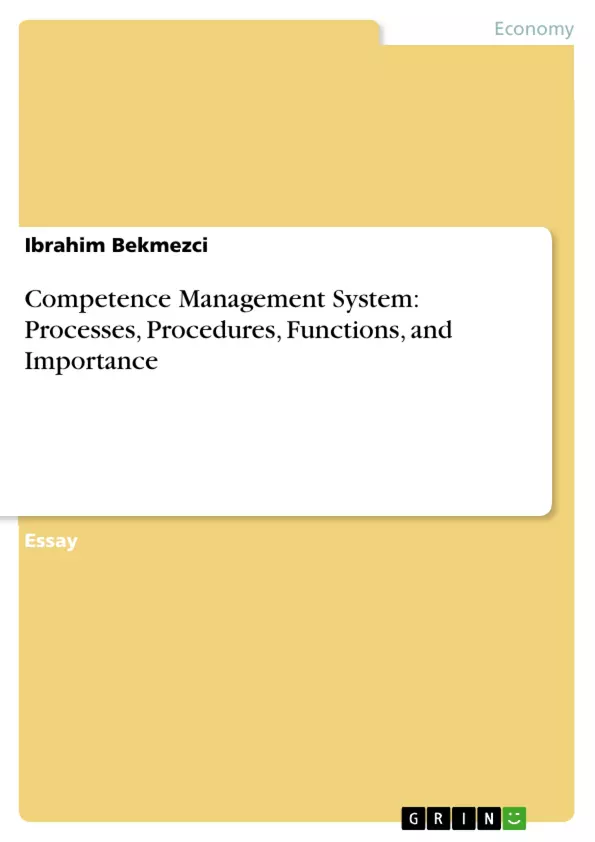What are competencies, and what is competence management?
Why is competence management important, and how does it help?
What are the goals and tasks of competence management?
Which approaches, levels and models does competence management have, and how do they help with complex processes and procedures?
What are the advantages and disadvantages of a competence management system?
Competencies and thus competence management play an increasing role in all organizations of the global economic system. In today's ever-changing business world, successful companies must continuously align their processes with the requirements of customers and products. Therefore, more and more companies are establishing competency management. The more competence management is anchored in organizations, the more successfully and smoothly run well-organized processes, policies, and procedures in an organization. Ultimately, competence management not only ensures lasting competitive advantages, but also the flexibility and innovative ability of employees and thus the survival of the company in a competitive business world.
Table of Contents
- Introduction
- What are Competencies?
- What is Competence Management?
- Goals of Competence Management
- Tasks of Competence Management
- Approaches and Levels of Competence Management
- Competence Management Model
- The Benefits of Competence Management
- The Disadvantages of a Competence Management System
- Conclusion
Objectives and Key Themes
This study aims to explain competence management processes in modern organizations from a business perspective, discussing internal problems, potential solutions, advantages, and disadvantages. It seeks to provide a current contribution to academic research. The study addresses the increasing importance of competence management in navigating complex and uncertain market conditions.
- Defining competencies and competence management
- The importance and benefits of competence management
- Goals and tasks of competence management systems
- Approaches, levels, and models within competence management
- Advantages and disadvantages of competence management systems
Chapter Summaries
Introduction: This introductory chapter establishes the context of competence management, questioning its nature and significance in modern organizations. It highlights the increasing uncertainty in business environments and emphasizes the need for individuals and organizations to develop advanced self-organization skills. The chapter underscores the growing role of competence management in ensuring organizational success and survival in today's dynamic market.
What are Competencies?: This chapter delves into the multifaceted definition of "competence," acknowledging the existing ambiguity and diverse interpretations. It explores various dimensions of competence, including social, communicative, emotional, personal, methodical, and technical aspects. The chapter contrasts the broader understanding of competence, encompassing knowledge, skills, and personality traits, with narrower definitions focusing solely on the ability to act. It highlights the importance of both formal and informal learning in developing competencies and emphasizes the ability to apply knowledge practically in complex situations as a key component.
What is Competence Management?: This chapter defines competence management as a systematic approach to harnessing employees' skills, knowledge, and professionalism to achieve organizational objectives. It explains how competence management helps companies track the three components of competence: ability, interest, and knowledge. The chapter stresses the importance of competence management in optimizing resource utilization, improving customer service, and ensuring organizational success, especially in the context of an increasingly competitive global business environment.
Keywords
Competence management, competency management system, skills, knowledge, organizational success, self-organization, competitive advantage, business administration, global economy, employee development.
Frequently Asked Questions: A Comprehensive Language Preview on Competence Management
What is the overall focus of this text?
This text provides a comprehensive overview of competence management, exploring its definition, goals, processes, benefits, and drawbacks within the context of modern organizations. It examines various aspects of competence, including its multi-faceted nature and the different approaches to managing it effectively.
What topics are covered in the Table of Contents?
The Table of Contents includes an introduction, a definition of competencies, an explanation of competence management, its goals and tasks, different approaches and levels, a model for competence management, its benefits and disadvantages, and a conclusion.
What are the main objectives and key themes of the study?
The study aims to explain competence management processes from a business perspective, addressing internal challenges, solutions, advantages, and disadvantages. It highlights the growing importance of competence management in navigating complex and uncertain market conditions. Key themes include defining competencies and competence management, its benefits, goals and tasks of systems, approaches and models, and finally, its advantages and disadvantages.
How are competencies defined in this text?
The text acknowledges the multifaceted nature of "competence," encompassing various dimensions such as social, communicative, emotional, personal, methodical, and technical aspects. It distinguishes between broader definitions that include knowledge, skills, and personality traits, and narrower definitions focusing solely on the ability to act. The ability to apply knowledge practically in complex situations is highlighted as crucial.
What is competence management according to this text?
Competence management is defined as a systematic approach to harnessing employees' skills, knowledge, and professionalism to achieve organizational objectives. It involves tracking ability, interest, and knowledge. The text emphasizes its importance in optimizing resource utilization, improving customer service, and ensuring organizational success in a competitive global market.
What are the benefits and drawbacks of competence management systems?
The text highlights the benefits of improved resource utilization, enhanced customer service, and increased organizational success. However, it also acknowledges potential disadvantages, although these are not explicitly detailed in the provided preview.
What are the key chapters and their summaries?
The preview includes summaries for the introduction and chapters on defining competencies and defining competence management. The introduction establishes the context and highlights the importance of competence management in uncertain business environments. The "What are Competencies?" chapter delves into the multifaceted definition of competence, while "What is Competence Management?" defines the systematic approach and its organizational benefits.
What are the keywords associated with this text?
Keywords include competence management, competency management system, skills, knowledge, organizational success, self-organization, competitive advantage, business administration, global economy, and employee development.
- Citation du texte
- Ibrahim Bekmezci (Auteur), Competence Management System: Processes, Procedures, Functions, and Importance, Munich, GRIN Verlag, https://www.grin.com/document/1245098



